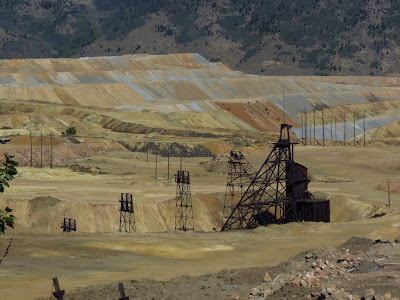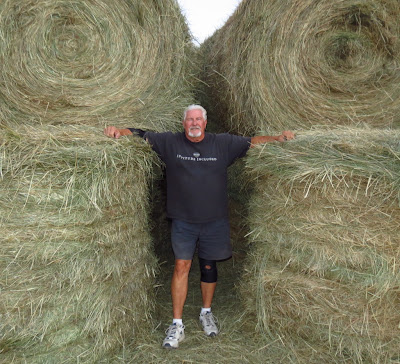Boy was I surprised when we drove in and saw all of those mine headframes...it was like Disneyland to me. The town was built on the "richest hill in history". Copper was king in the late 1800's and early 1900's due to the invention of electricity and then WW1 help too.
I believe there are still 12 or 13 headframes in the city of Butte and surrounding suburbs. Some are framed nicely as this one was within some of the old brick buildings.
Some headframes give the name and a bit of history, as in how many miners died on the mine.
Others had small house built onto them...
Butte is also famous for the thousands of historic buildings, some have been very lovingly preserved.
Some still have the original names on them.
As always in these western towns is the Chinese history to go with them.
Main street is as vibrant and well preserved as we have seen on our trip so far.
The Berkeley Pit. In 1955, after buying up many mines and some suburbs of Butte, the Berkeley Pit was opened. By the time it closed in 1982 it was more than a 1/2 mile wide and 1700 feet deep. They ground water is slowly filling up the pit with toxic water and won't get to ground level until 2018.
This is a "super fund" site because of acidity of the water. It's filled with arsenic, cobalt, magnesium, copper and zinc and this plant cleans about 100,000 gallons a day...way to little.
They are actually working a pit very near to the original "Berekely Pit".
Where the hell is ACLU? Just kidding. It's great to see this statue, "Our Lady of the Rockies", a 90 foot tall figure overlooking the valley below.
Next town 30 miles away is Anaconda, which also had a huge copper pit. This is St. Peters, built in 1898 and still beautiful today.
While the mine closed in 1980 the town look lively and we did not see the typical boom-bust look of a town. One claim to fame for this town was in 1903 a socialist mayor, police force and town counsel were elected. It was short lived though.
This old smelting pot was out front of the aged copper shop in previous photo. The gate was open so that's an invitation in my book.
"The Montana Stack", when build in 1919 was the largest free standing masonry structure on earth. There are some who think this distinction still stands. Funny, this is a state park that you can never set foot in because the ground is so toxic you can not come near it.
On our way home for the day we ventured towards Wisdom, Montana for dinner at "The Crossing". Here the Big Hole River crowds trees as it flows through the valley.
Birds...always birds! We saw this immature bald eagle sitting near the river.
We have passed these contraptions the last month without knowing what the are or what they do. Seems every other farm in the valley had one.
Talked to a lady we had befriended in Wisdom who filled in all the blanks. This is a "beaverslide". Invented right here in the valley over 100 years ago as a way of making hay loafs, instead of round or square bales. Not many farms still use it but this one, 18 miles out of the way, still does. The loaf in the middle is approximately 50 feet long and 12 feet tall.
This is how we normally see hay baled in this part of the country.
This pile might be stacked very much the same as a loaf
so it's easy to see how the loaf (or haystack) fell out of favor.






















1 comment:
great pics with a bit of history, nice that it's pretty much all kept up.
So let me see if I understand this other angle, the "company" mines the product out of the ground, sells it and makes a profit, leaves and turns over the ruins to be cleaned up by who?
Who funds the "superfund" site operations? not to mention if the poisonous waters ever enter a stream or river.
Rules and regulations are sooo over rated.
Joe
Post a Comment